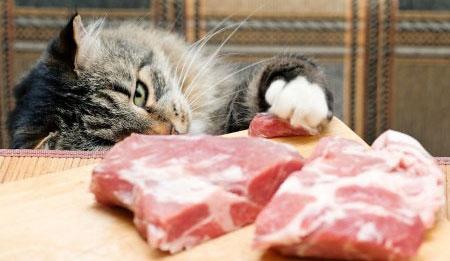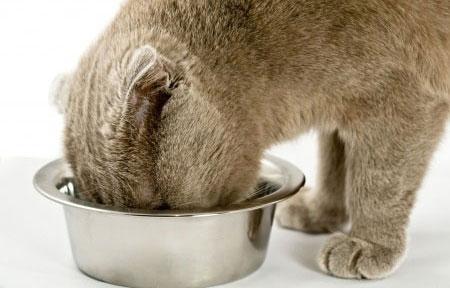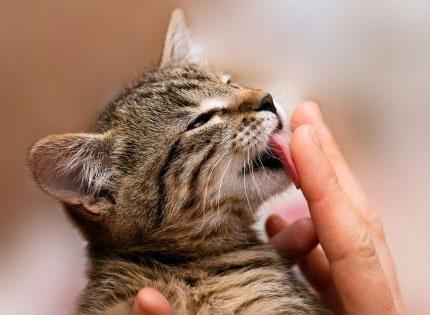This content is archived from the Feline Nutrition Foundation
Just What is a Raw Cat Food Diet, Anyway?
- Updated: Sunday, June 02, 2019 02:16 PM
- Published: Tuesday, February 09, 2010 09:22 AM
- Written by Margaret Gates
 All cats, small or large, are true carnivores, obligate carnivores. This means they must eat meat to survive. There are no vegan cats. Because they evolved to fill this top-predator niche, their bodies are specifically geared to process a prey-based diet. This is as true for a tiger as it is for the cat on your lap.
All cats, small or large, are true carnivores, obligate carnivores. This means they must eat meat to survive. There are no vegan cats. Because they evolved to fill this top-predator niche, their bodies are specifically geared to process a prey-based diet. This is as true for a tiger as it is for the cat on your lap.
Raw cat food is a way to feed cats a more natural diet. By natural we mean bio-appropriate. A diet that fits their true nutritional requirements. The benefits to your cat are enormous. And it isn't hard at all. Raw food for cats can be found frozen at enlightened pet stores, purchased online and delivered right to your door, or if you are a do-it-yourselfer, can be made at home. See "Feline Nutrition's Easy Homemade Cat Food Recipe."
What about a cat's diet in the wild? Why does it matter? Because cats aren't domesticated. Humans haven't changed cats much at all. We haven't messed with their basic form and value them for their wild abilities i.e. hunting rodents. It is only recently that we have tried to feed cats a processed, carbohydrate-filled diet. It is no coincidence that this same period also exhibited a dramatic increase in disease and obesity in cats as we moved away from natural cat nutrition.
 In the wild, cats eat whole, raw prey. Their diet includes mice, rats, any other small rodents available, rabbits, insects, amphibians and birds. They usually eat the whole animal, meat, bones, brains, organs and fur. Their systems are uniquely set up to metabolize this diet which is high in moisture, high in protein and very low in carbohydrates. Because this is the diet they have relied upon for tens of thousands of years, they do not have the ability to process carbohydrates very well. Cats get most of their energy from the glucose their livers process from protein, not carbohydrates.¹ Not only are carbohydrates hard for your cat's system to handle, but they are also detrimental to your cat's health.² Think about that the next time you see pretty pictures of grains and vegetables on the front of a bag of commercial cat food.
In the wild, cats eat whole, raw prey. Their diet includes mice, rats, any other small rodents available, rabbits, insects, amphibians and birds. They usually eat the whole animal, meat, bones, brains, organs and fur. Their systems are uniquely set up to metabolize this diet which is high in moisture, high in protein and very low in carbohydrates. Because this is the diet they have relied upon for tens of thousands of years, they do not have the ability to process carbohydrates very well. Cats get most of their energy from the glucose their livers process from protein, not carbohydrates.¹ Not only are carbohydrates hard for your cat's system to handle, but they are also detrimental to your cat's health.² Think about that the next time you see pretty pictures of grains and vegetables on the front of a bag of commercial cat food.
Many of the nutrients cats need must come from animal sources. Arachidonic acid, an essential fatty acid, is found only in meat. Cats must consume preformed vitamin A from animal sources because, unlike dogs or humans, they do not have the ability to make it from plant-derived beta carotene.³ Taurine is essential for cats and is only found in meat sources, not plants. A taurine deficiency can cause blindness and heart problems.⁴ Taurine is also found in high levels in insects.⁵
What About Food Poisoning?
You might worry about salmonella. Of course salmonella is out there, but as with meat you would prepare for yourself, following safe handling practices minimizes the risk. Cats are resistant to bacteria such as salmonella, which makes sense for an animal that evolved to exclusively eat raw meat. Their stomachs are much more acidic than a human's. They have very short digestive tracts; shorter than any other comparably-sized mammal. Food normally passes through their systems in about 12 hours. This doesn't give bacteria much time to proliferate and make the cat sick. Compare that to humans, where food takes 36-48 hours to pass through, and you can see why humans are much more susceptible to bacterial pathogens. Parasites are killed by freezing the food. Almost all recalls due to salmonella or other contamination in pet food involved canned or dry foods. A recall in 2007 that sickened about 78 people with salmonella was traced to dry pet food. Interestingly, none of the animals that ate it got sick.⁶
 From Your Cat: Simple New Secrets to a Longer, Stronger Life by Elizabeth Hodgkins, DVM: "If there can be no fundamental objection to the mere idea of raw meat as a diet for the cat, what legitimate objections might there be about the practical aspect of feeding raw meat to felines? The first objection would be the possibility of food poisoning from bacterial contamination of the meat. While this is certainly a possibility, just as food poisoning of humans who eat raw meat (I love sushi and sashimi!) is always at least a possibility, the reality is highly controllable and overstated, in my opinion and the opinion of many others. Human-grade ground and whole raw meats for pets are available today because of the growing popularity of the practice of among pet owners. These meats are handled carefully by the processor, and frozen immediately after processing."
From Your Cat: Simple New Secrets to a Longer, Stronger Life by Elizabeth Hodgkins, DVM: "If there can be no fundamental objection to the mere idea of raw meat as a diet for the cat, what legitimate objections might there be about the practical aspect of feeding raw meat to felines? The first objection would be the possibility of food poisoning from bacterial contamination of the meat. While this is certainly a possibility, just as food poisoning of humans who eat raw meat (I love sushi and sashimi!) is always at least a possibility, the reality is highly controllable and overstated, in my opinion and the opinion of many others. Human-grade ground and whole raw meats for pets are available today because of the growing popularity of the practice of among pet owners. These meats are handled carefully by the processor, and frozen immediately after processing."
A Healthy Alternative
"There is only one best cat in the world, and every family owns it." –Unknown
Your cats are part of your family, and of course you want what is best for them. There is growing evidence that feeding dry food causes many of the diseases that cats are suffering from in ever larger numbers.⁷ Diet plays a huge role in the health of your animals, so choosing a diet that reflects what a cat would eat in the wild makes a lot of sense. Feeding a balanced raw cat food diet is feeding a healthy diet. Cats' systems are perfected to handle just this kind of food.
 Raw food for cats, whether commercial or homemade, usually consist of ground meat, bone and organs, along with eggs, water and supplements. Ideally, your cat should also get some raw meaty bones, given whole. Some commercial raw meals include vegetable matter, but this is usually a very small amount of around 1-5%. Notice that grain is completely absent. Cats are not cows. Grain has no place in a cat's diet. Dry food and low-quality canned food are mostly grain. The goal is to get as close as we can to a prey-based diet without having to resort to live prey.
Raw food for cats, whether commercial or homemade, usually consist of ground meat, bone and organs, along with eggs, water and supplements. Ideally, your cat should also get some raw meaty bones, given whole. Some commercial raw meals include vegetable matter, but this is usually a very small amount of around 1-5%. Notice that grain is completely absent. Cats are not cows. Grain has no place in a cat's diet. Dry food and low-quality canned food are mostly grain. The goal is to get as close as we can to a prey-based diet without having to resort to live prey.
Meat
Many different kinds of meat can be used in raw cat food. In fact, you should vary the kinds of meat you feed, not only for variety, but also to be sure your cat gets a balanced diet. The important difference between most raw food companies and the rest of the pet food industry is that raw cat food is made with human-grade meat, frequently free-range and sometimes organic. Raw food products do not use any rendered ingredients or meat meals.
Chicken, turkey and rabbit are favorites. You also can find duck, pheasant, Cornish game hen, quail, venison and even ostrich. Surprisingly, even though cats would never hunt deer, wild venison is very close nutritionally to a cats' natural prey.⁸ Most people try to feed meat that is close to what cats would naturally be eating, so meat such as beef, which can cause allergic reactions in some cats, lamb and pork are used less often. Fish should be avoided except for occasional use for many reasons including: heavy metal contamination, vitamin E depletion and the fact that cats get addicted to it because of its strong taste.⁹
Bone
A surprise to many, raw bone is highly digestible and provides calcium, minerals and enzymes. The marrow is nutrient rich. It is only cooked bone that is dangerous. Cooking makes bone sharp, brittle and almost impossible to digest.¹⁰ In addition to including the bone in ground food, small cuts of meat with bones such as chicken wings or Cornish hens can be given to cats. Once they catch on to the idea, they will eat the whole thing, bone and all. It's great for their teeth and jaws, besides being nutritious.
Raw cat food diets try to balance the meat to bone ratio to match that of a wild diet, usually mouse or rabbit. This balances the calcium to phosphorus ratio. Cats cannot live on meat alone. Their calcium source is ideally from bone, not a supplement, as bone provides other minerals such as copper and zinc, along with collagen.¹¹
Organ Meat

Organ meats, such as liver and kidney, contain key ingredients your cat needs: B vitamins, vitamin A, amino acids and essential fatty acids. Heart is a particularly good source of taurine, a vital amino acid. Heart is usually counted as muscle meat for the purposes of raw food for cats, not as organ meat. Both commercial and homemade raw cat foods usually add taurine as a supplement, even when fresh heart is included, to be sure of providing enough of this essential amino acid.
Egg
Eggs provide valuable protein and are a source of vitamin A, and essential amino acids such as taurine and arginine.
Water
Water is added because a cats' natural prey is 65-75% water. Cats evolved in dry climates and depended on the prey they ate as a primary source of water, so their thirst drive is not strong. Cats need to have water in their food to stay properly hydrated.¹²
Supplements
This is perhaps the wrong word to use, as they aren't just supplemental, they are required. They are added to make up for the fact that the whole animal is not being used, and that grinding and freezing does cause some loss of nutrients. Supplements added include taurine, B vitamins, vitamin E and essential fatty acids. Many of these are found in the head of the animal, specifically in the brains and eyes. The head is not always included in the mix. Ever wonder why a cat eats the head of the mouse first? He knows what's good for him!
Why Raw Instead of Cooked?
So why not just cook it? Cooking degrades nutrients in meat, causing losses of vitamins, minerals and amino acids. Cooking also transforms nutrients, changing their chemical composition and making them less bioavailable to your cat.¹³ Cooking bone locks the minerals in place. This makes the minerals unavailable and causes bone to splinter easily, which is very dangerous. Canned cat food manufacturers add these vitamins and minerals back in after the product is cooked to make up for this loss.¹⁴ This supplementation is not exact, as there are nutrient losses which aren't recognized or replaced. Feeding raw cat food is the best way to be sure your cat is getting the most from his food.
Additional Reading
Beginner's Luck: Where Do I Start?
Easy Raw Cat Food for the Busy Person
 Switching to raw food for cats allows you to know what you are feeding. You will feel much more comfortable knowing the wholesomeness of each ingredient you feed your cat, rather than worrying about some vague or misleading description on a label. You don't want your cat eating food not fit for human consumption, or some mystery meat meal. Look at the ingredient list on a package of frozen raw cat food. You will see meat first on the list, then the other whole ingredients and supplements. No preservatives, by-products or fillers.
Switching to raw food for cats allows you to know what you are feeding. You will feel much more comfortable knowing the wholesomeness of each ingredient you feed your cat, rather than worrying about some vague or misleading description on a label. You don't want your cat eating food not fit for human consumption, or some mystery meat meal. Look at the ingredient list on a package of frozen raw cat food. You will see meat first on the list, then the other whole ingredients and supplements. No preservatives, by-products or fillers.
If your cat is on immune-suppressing drugs or is diabetic, you must discuss a change in diet with your veterinarian before proceeding. Immune-suppressing drugs can interfere with a cat's natural ability to deal with food pathogens. Many diabetic cats can benefit enormously from a raw cat food diet, greatly reducing or eliminating the need for insulin. It must be done with careful monitoring as diet can dramatically and immediately affect the amount of insulin required, risking overdose.¹⁵
Margaret Gates is the founder of the Feline Nutrition Foundation.
1. Claudia A. Kirk, Jacques Debraekeleer, and P. Jane Armstrong, "Normal Cats," Small Animal Clinical Nutrition,4th ed. Walsworth Publishing Company, 2000, 298-299.
2. J. S. Rand, L. M. Fleeman, H. A. Farrow, D. J. Appleton, and R. Lederer, "Canine and Feline Diabetes Mellitus: Nature or Nurture?," The Journal of Nutrition, August 2004.
Peter J. Markwell, C. Tony Buffington, and Brigitte H. E. Smith, "The Effect of Diet on Lower Urinary Tract Diseases in Cats," The Journal of Nutrition 128, no. 12, December 1998, 2753S-2757S.
3. Claudia A. Kirk, Jacques Debraekeleer and P. Jane Armstrong, "Normal Cats," Small Animal Clinical Nutrition,4th ed. Walsworth Publishing Company, 2000, 303.
4. Kirk and others, 301.
5. R. Huxtable, "Physiological Actions of Taurine," Physiological Reviews 72, 1992, 101-163.
6. "Update: Recall of Dry Dog and Cat Food Products Associated with Human Salmonella Schwarzengrund Infections – United States, 2008," Morbidity and Mortality Weekly Report, Centers for Disease Control, November 7, 2008.
7. A. Prahl, DVM, L. Guptill, DVM, PhD, Dipl ACVIM, N. W. Glickman, MS, MPH, PhD, M. Tetrick, DVM, PhD, and L. T. Glickman, VMD, DrPH, "Time Trends and Risk Factors for Diabetes Mellitus in Cats Presented to Veterinary Teaching Hospitals," Journal of Feline Medicine and Surgery 9, October 2007, 351-358.
J. S. Rand, L. M. Fleeman, H. A. Farrow, D. J. Appleton, and R. Lederer, "Canine and Feline Diabetes Mellitus: Nature or Nurture?," The Journal of Nutrition, August 2004.
Peter J. Markwell, C. Tony Buffington, and Brigitte H. E. Smith, "The Effect of Diet on Lower Urinary Tract Diseases in Cats," The Journal of Nutrition 128, no. 12, December 1998, 2753S-2757S.
8. Ellen S. Dierenfeld, PhD, Heather L. Alcorn, BS, and Krista L. Jacobsen, MS, "Nutrient Composition of Whole Vertebrate Prey (Excluding Fish) Fed in Zoos," U.S. Department of Agriculture, May 2002.
9. "Histamines in Fish," State Government of Victoria Department of Health, Australia, 2000.
"Mercury in the Environment," Fact Sheet 146-00, U.S. Geological Survey, October 2000.
"PCBs in Fish and Shellfish," Environmental Defense Fund, August 2005.
Board on Agriculture, Nutrient Requirements of Cats, rev. ed. The National Academies Press, 1986, 32.
10. Dr. Bruce Syme, BVSc (Hons), "Feeding Raw Bones to Cats and Dogs."
11. Board on Agriculture, Nutrient Requirements of Cats, rev. ed. The National Academies Press, 1986, 18.
12. Board on Agriculture, 29.
13. N. Gerber, M. R. L. Scheedera, and C. Wenk, "The Influence of Cooking and Fat Trimming on the Actual Nutrient Intake from Meat," Meat Science 81, January 2009, 148-154.
14. Christopher S. Cowell, Neil P. Stout, Mark F. Brinkman, Edward A. Moser, and Stephen W. Crane, Small Animal Clinical Nutrition,4th ed. Walsworth Publishing Company, 2000 , 133.
15. Nicole Bennett, DVM, MS, ACVIM, Deborah S. Greco, DVM, PhD, Mark E. Peterson, DVM, Claudia Kirk DVM, PhD, Mark Mathes, BS, and Martin J. Fettman, DVM, PhD, "Comparison of a Low Carbohydrate – Low Fiber Diet and a Moderate Carbohydrate – High Fiber Diet in the Management of Feline Diabetes Mellitus," Journal of Feline Medicine and Surgery 8, no. 2, April 2006, 73-84.




